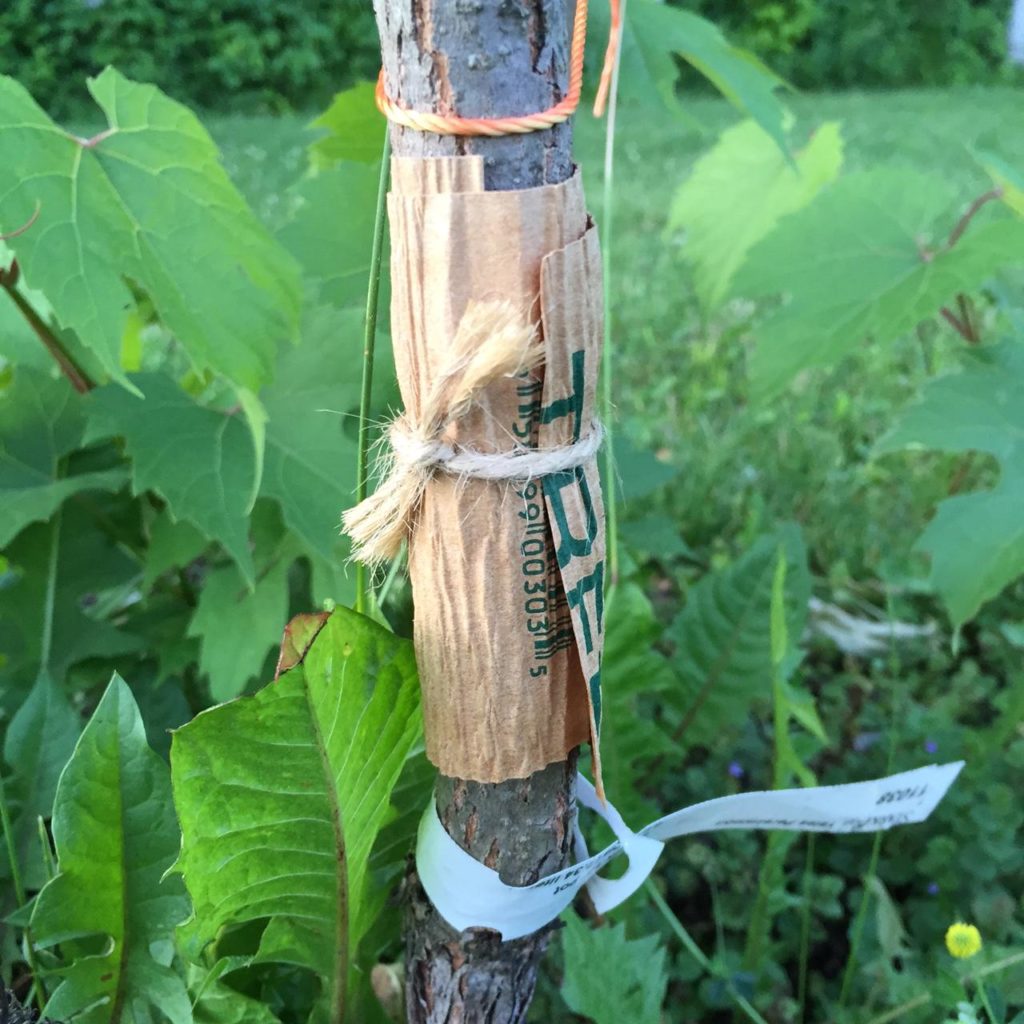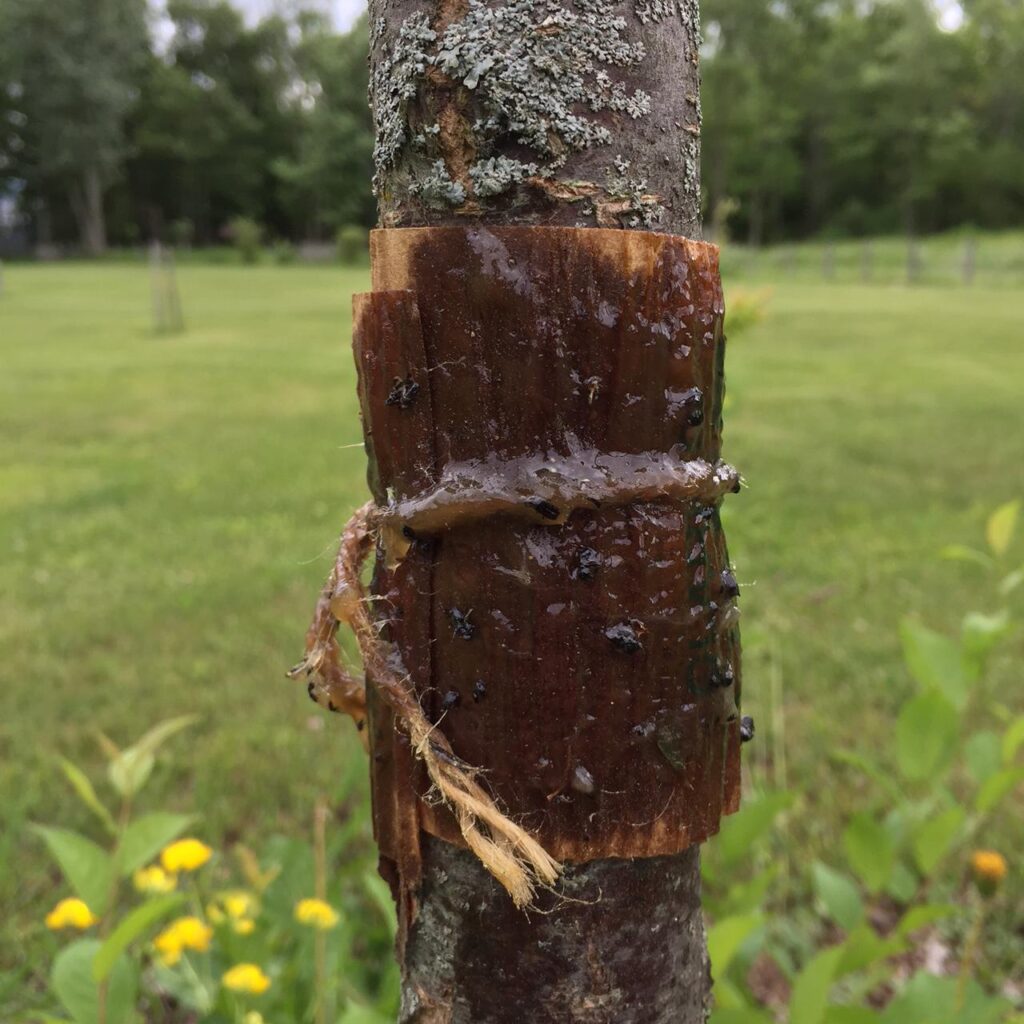It’s time for a follow-up to my Organic Orcharding post, specifically a detailed look at how to use Tanglefoot for non-toxic pest control in a holistic fruit tree orchard. For readers wondering about zone compatibility and looking for a regional reference to help you evaluate the relevance of this post to your individual growing conditions, our orchard is located in Essex, New York along the Adirondack Coast of the Champlain Valley. We are purists when it comes to holistic orcharding and gardening (despite challenges unique to growing fruits and vegetables in the North Country) and we have come to rely on Tanglefoot summer after summer. (You may also want to check out my post, “How to Apply Tanglefoot to Trees“ for a simple, straightforward how-to video. Your holistic orchard will thank you in abundance!)
Pre-Goo & Post-Goo
Here’s a glimpse at the first two phases of Tanglefoot installation, documented in Rosslyn’s 100% organic orchard. This first photo was taken just before the sticky goo was lathered onto the corrugated paper.

So tidy, right? Not for long! Here’s what it looks like after the sticky Tanglefoot is installed.

Yuck! Hopefully the noisome critters that like to climb up the trunks of fruit trees agree.
It’s a messy installation process, but it seems to work pretty well.
How to Use Tanglefoot
I’ll prologue the most important part of this post by saying two things:
- Applying Tanglefoot to fruit trees a messy but relatively straightforward task.
- Better instructors have already explained application, so I’ll defer to their able guidance rather than overlook something important.
One of the best step-by-step Tanglefoot installation videos was made by San Diego master gardeners Carol Graham (unfortunately no longer available online). Similarly thorough written instructions are provided by the products’s manufacturer, Contech-Inc:
We recommend using 4” wide wrap of waterproof paper or tape on the trunk of the tree and applying Tree Tanglefoot over the wrap. Tree Tanglefoot is oil-based and the oils will soak into the bark. Banding material eliminates staining of the tree and offers quick, complete removal of the sticky material. In addition, Tree Tanglefoot will remain sticky longer when applied on top of a surface resistant to oil. For rough bark trees it may be necessary to plug the gaps between the tree trunk and the banding, this can be done by using insulation or other materials.
Apply Tree Tanglefoot Insect barrier in a uniform fashion. It can be applied in a heavy or light coat. Heavy coats are approximately 3” wide and 3/32” thick. A heavy coat is used when the insects to kept from the tree foliage are large or numerous, or when there is little time available to maintain the band. Light coats are 3” wide and 1/16” thick. A light coat is good as a general barrier against smaller or less numerous insects, or when the band can be maintained regularly.
Generally, Tree Tanglefoot will remain sticky and effective until it is covered with insects, dust or other debris. A build-up of debris or insects will create a bridge for other insect to cross. This debris requires removal and possible re-application in spots. If an area is unusually dusty or the surface of the barrier is stiffened, Tree Tanglefoot can be rubbed around to expose a new sticky layer beneath. Remove bands at end of season. (Source: Tree Tanglefoot Insect Barrier Products – Contech Inc)
Still a little uncertain? (Or just procrastinating to avoid making a gooey-sticky mess?) Here’s another resource I’ve also relied upon for amazing step-by-step Tanglefoot guide with photographs. Here are the simple, straightforward instructions.
Using a putty knife or a cake decorating spatula. If you choose a putty knife be very careful with the edges and corners as they are very sharp and can easily damage the bark of the tree. I recommend using a cake decorating spatula because they have rounded edges at the tip.
1. Wrap your tree in plastic film
2. Soften up a glob of Tanglefoot with the spatula
3. Work it into a smooth lump without strings back to the bucket
4. Apply the product in a thin 1″ wide band a few inches from the top of the plastic all the way around the tree creating a complete circle
5. Drag your spatula in the same direction that you wrapped the tree with the plastic. If you go the other way you’ll just pull the plastic right off
6.Make another band of Tanglefoot a few inches down from the first band. This creates 2 barriers that work together to stop the pests from walking up your tree (Source: How to Use Tanglefoot – Backyard Food Growing)
I use the paper “tape” version and have not yet tried the plastic film, but I’m intrigued. However this post made me wary.
I got some Tanglefoot this year for my apple trees, had a lot of problems with ants last year. I tried attaching bands of saran wrap around the tree trunks and applying the Tanglefoot that way. That was a complete disaster/mess, so I called the Tanglefoot manufacturer and asked if it would harm my trees to apply their product directly to the bark. They said that other than a dark ring/stain around the tree, no, it should not harm the tree at all to be directly applied. So, that is what I did. Did it about a month ago. No signs of any tree trouble yet. (Source: Putting tanglefoot on trees directly – GardenWeb)
I decided to ask the author, Stacy, the about plastic wrap vs. paper banding.
Great post, and the photo play-by-play is the best resource I’ve found online! Thank you. This is my first foray into fruit tree pest tangling (wrangling?), and I’m curious about your preference for plastic wrap instead of the paper/cardboard option proposed by the manufacturer. I’m guessing you’ve tried both and decided that the plastic wrap works better? Would you be willing to explain the pros and cons of plastic instead of paper? Hoping to get this right the first time! Thanks.
Stacy answered my question the very same day (Wow! Thanks, Stacy.) as follows:
Thank you! I’m happy the pictures are helpful for you. You’ll do just fine, the hardest part is keeping it off of yourself and your clothes! I have a few reasons for the plastic.
The method that I show here (with the two stripes/plastic/cotton balls) was the way I was taught during my first experience with Tanglefoot, I didn’t even know about the cardboard at that point. It wasn’t until I started working in a retail nursery a few years later that I found out about the cardboard wrap.
I think the cardboard wrap could be good if your tree is perfectly smooth, as it leaves gaps that the bugs can walk under unobstructed. It might work ok if you put cotton balls under it and secure it tightly to close those gaps though.
Also, I don’t choose the cardboard because I live in a very rainy climate and the cardboard would disintegrate in no time at all. If your area is less rainy then it would probably be ok. I prefer the plastic too because it holds tight to the bark and stays put for the month or two that it’s on there.
I’ve just continued to use the plastic/cotton balls method because it was simple and used items I already had at home, there wasn’t an additional product that I needed to buy.
It’s just important to get the plastic off when the season is done or when the Tanglefoot becomes ineffective, the plastic allows no airflow for the bark. This would be a benefit to using the cardboard. (Source: backyardfoodgrowing.com)
Thanks again, Stacy.
Needless to say, I still haven’t tried the plastic film. Three years of installation with paper wraps, and the approach seems to be working. So, if it ain’t broke don’t fix it!
Would like to know when in the season to apply and if it stops earwigs from climbing? I heard that you can use duct tape which would be way easier and a sturdy alternative to plastic wrap. That is what I plan to do, duct tape a band on my pear tree.
Thanks for your comment and question, Howard. We install these sticky wraps/traps at the beginning of the growing season and replace them partway through the growing season, if it’s a fast growing young tree. Otherwise we just remove them at the end of the growing season (to avoid girdling the trees.) As for earwigs, I believe that they too would get stuck. And your duct tape might be ann effective alternative to protect your pear tree so long as it stays sticky. I’d be interested in an update reporting on whether or not your solution works!